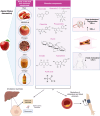Potential of Fruits to Improve Dyslipidemias: A Pilot Review
- PMID: 40322293
- PMCID: PMC12050025
- DOI: 10.2147/VHRM.S488465
Potential of Fruits to Improve Dyslipidemias: A Pilot Review
Abstract
Dyslipidemia is a condition characterized by excessive lipids in the blood plasma, including triglycerides (TG), total cholesterol (TC), low-density lipoprotein cholesterol (LDL-C) and decreased levels of high-density lipoprotein cholesterol (HDL-C), which is generated mostly due to obesity. This study aims to summarize research conducted on rats and humans regarding the potential of eight fruits in reducing dyslipidemia and their associated health benefits (eg, reduction of free radicals, hypoglycemic effects, weight reduction, lowering of blood pressure, and anti-inflammatory properties). The studied fruits include pomegranate, star fruit, Rosa roxburghii, pineapple, tree tomato, coffee, apple, and passion fruit. Various parts of these fruits, such as the root, leaves, stem, peel, and pulp, were analyzed for their effects. These fruits are edible, widely available, and cost-effective when purchased during the harvest season (Graphical abstract).
Keywords: benefits; dyslipidemias; fruits; humans; rats.
© 2025 Flores Flores et al.
Conflict of interest statement
The authors report no conflicts of interest in this work.
Figures










Similar articles
-
Studies on antidyslipidemic effects of Morinda citrifolia (Noni) fruit, leaves and root extracts.Lipids Health Dis. 2010 Aug 20;9:88. doi: 10.1186/1476-511X-9-88. Lipids Health Dis. 2010. PMID: 20727145 Free PMC article.
-
Biochemical and histopathological study of the anti-hyperglycemic and anti-hyperlipidemic effects of cornelian cherry (Cornus mas L.) in alloxan-induced diabetic rats.J Complement Integr Med. 2014 Jun;11(2):63-9. doi: 10.1515/jcim-2013-0022. J Complement Integr Med. 2014. PMID: 24710636
-
Molecular sources of residual cardiovascular risk, clinical signals, and innovative solutions: relationship with subclinical disease, undertreatment, and poor adherence: implications of new evidence upon optimizing cardiovascular patient outcomes.Vasc Health Risk Manag. 2013;9:617-70. doi: 10.2147/VHRM.S37119. Epub 2013 Oct 21. Vasc Health Risk Manag. 2013. PMID: 24174878 Free PMC article. Review.
-
Antidiabetic and antilipidemic effects of Manilkara zapota.J Med Food. 2015 Mar;18(3):385-91. doi: 10.1089/jmf.2013.0170. Epub 2014 Sep 3. J Med Food. 2015. PMID: 25184814
-
Almonds and Cardiovascular Health: A Review.Nutrients. 2018 Apr 11;10(4):468. doi: 10.3390/nu10040468. Nutrients. 2018. PMID: 29641440 Free PMC article. Review.
References
-
- Isas AS, Escobar F, Álvarez-Villamil E, et al. Fermentation of pomegranate juice by lactic acid bacteria and its biological effect on mice fed a high-fat diet. Food Biosci. 2023;53:102516. doi:10.1016/j.fbio.2023.102516 - DOI
-
- Halim NAA, Karim CF, Mohammed IK, et al. Anti-obesity effect of methanolic extracts of local punica granatum in high-fat diet-induced obese rats. Malaysian J Med Health Sci. 2023;18(2):228–236. doi:10.47836/MJMHS.19.2.33 - DOI
Publication types
MeSH terms
Substances
LinkOut - more resources
Full Text Sources
Medical
Miscellaneous

